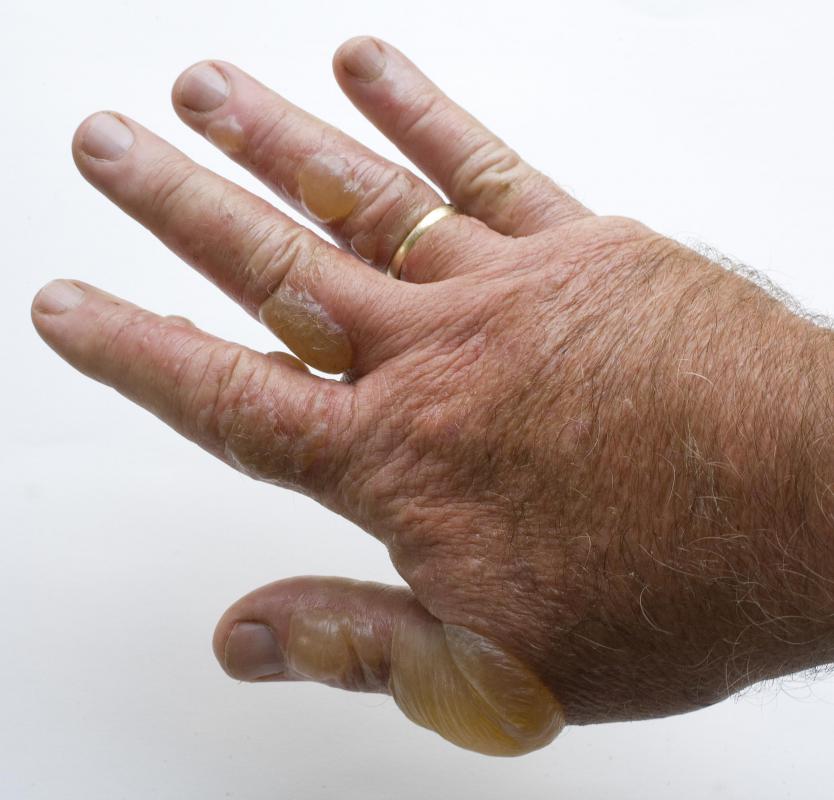At HomeQuestionsAnswered, we're committed to delivering accurate, trustworthy information. Our expert-authored content is rigorously fact-checked and sourced from credible authorities. Discover how we uphold the highest standards in providing you with reliable knowledge.
What is Urushiol?
Urushiol is a type of toxin that is usually found in plants. While organic, this toxin can cause skin irritation. Plants that commonly contain urushiol include poison oak, poison ivy, and sumac. Interestingly, some people contract urushiol-induced contact dermatitis due to confusion within the human body.
Urushiol has the ability to trick the human body into believe that it is under attack. As soon as the immune system senses an attack, T-cells that are inside of the blood release enzymes and toxins. T-cells are highly damaging to both good and bad cells. When the fluids released from the T-cells damage nerves, the result is itchy skin.

Urushiol can cause itching in humans, though it does not affect most animals. Birds, deer, goats, horses, and cattle all consume berries from toxic plants without harm. Curiously, 90% of all adults react negatively to toxic plants. At this time, scientists have not determined why some people are affected by urushiol, while others are not.
The part of a toxic plant that generally causes a reaction looks a lot like syrup. In fact, the name urushiol comes from the Japanese word urushi, which refers to a type of lacquer that is produced in East Asia from the sap of the kiurushi tree. The sap itself is not important to most toxic plants, though it does have an impact upon humans.

Poison ivy happens to be the one toxic plant that needs its sap to survive. When a poison ivy plant has been damaged, the plant releases its sap to help heal any wounds. Unfortunately for those that are allergic to poison ivy, this plant is highly sensitive. A simple brush against the plant will cause it to release its poisonous sap-like toxins.
There is a way to tell whether or not a poison ivy plant has been recently damaged. Plants that have released sap will appear shiny, or plant leaves may have small black spots on them. Poison ivy plants that appear shiny or spotted should be avoided. Then again, it's entirely possible to come in contact with toxic sap without ever entering a wooded area.

Toxic sap can be easily transferred from one person to another. In addition, an allergic reaction can occur if a person has come in contact with any item or animal that contains a toxic plant's oils. Dogs, cats, and even garden tools might contain enough of a plant's toxin to cause an allergic reaction. Lastly, the sap from toxic plants can be released into the air if these plants are used in order to create a campfire.
AS FEATURED ON:
AS FEATURED ON:

















Discussion Comments
Concentrated vinegar will kill poison ivy plants. Use a garden sprayer saturate leaves. The plant starts to brown and shrivel in short order.
It's very interesting how animals do not react to plants containing sap with urushiol like we do. Is it a genetic issue? Why haven't we developed immunity to these toxins like animals?
@Terrificli-- Oh yea, when plants with urushiol are treated, cut or dug up, all of the clothes have to be washed immediately. The gloves, if fabric, can be washed too. Otherwise, plastic gloves need to be thrown away. Some people also wash their hands or take a full shower with a special soap made specifically for the removal of urushiol. They actually sell soap for this, I have seen it.
And the tools used to cut or remove the plants have to be washed and cleaned completely or the urushiol will end up on the hands and arms during next use.
We have poison ivy on our property. I've noticed over the years that adult, mature poison ivy plants tend to have more urushiol and cause more issues. The young, immature plants do not affect as much.
Urushiol from poison ivy is so strong that in areas where there is a lot of poison ivy, people may become allergic without even touching it. Urushiol can irritate and inflame the lungs, airways and throat if breathed in. My sister has this problem and I do not allow her to wander around the property, especially when I'm mowing lawn or cutting poison ivy.
@Soulfox -- it is also a good idea to kill these plants when they show up in your yard (you need to learn to identify them, too). Some people have chosen the method of putting on rubber gloves, removing them and then burning them. Of course, there are other ways to remove them with bagging lawn mowers and such but you get the idea.
It is a very good thing that this article points out the danger of burning these plants.
Instead, of burning them grab some stuff specifically designed to kill these plants. Those products are pretty inexpensive and usually feature a nozzle that will allow you to spray a long stream so you won't have to get to close to the plants.
This is precisely why it is so important to recognize these nasty plants on sight. It is amazing how many people go plowing through the woods without being able to identify these very common plants and wind up unhappy and itching for days.
Post your comments